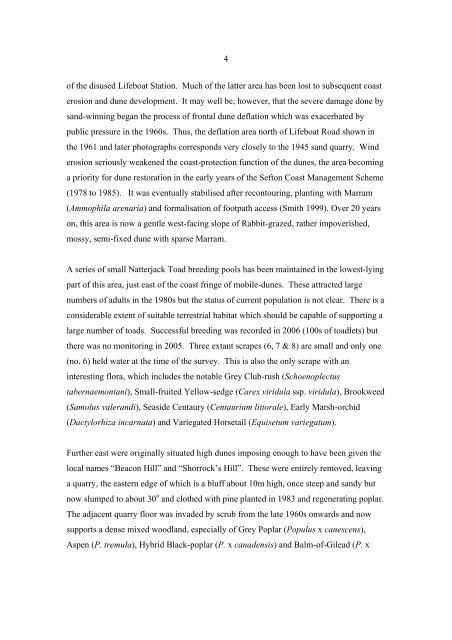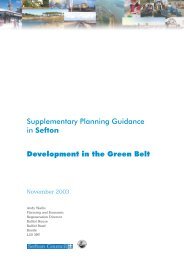The impact of sand extraction at Formby Point ... - Sefton Council
The impact of sand extraction at Formby Point ... - Sefton Council
The impact of sand extraction at Formby Point ... - Sefton Council
Create successful ePaper yourself
Turn your PDF publications into a flip-book with our unique Google optimized e-Paper software.
4<br />
<strong>of</strong> the disused Lifebo<strong>at</strong> St<strong>at</strong>ion. Much <strong>of</strong> the l<strong>at</strong>ter area has been lost to subsequent coast<br />
erosion and dune development. It may well be, however, th<strong>at</strong> the severe damage done by<br />
<strong>sand</strong>-winning began the process <strong>of</strong> frontal dune defl<strong>at</strong>ion which was exacerb<strong>at</strong>ed by<br />
public pressure in the 1960s. Thus, the defl<strong>at</strong>ion area north <strong>of</strong> Lifebo<strong>at</strong> Road shown in<br />
the 1961 and l<strong>at</strong>er photographs corresponds very closely to the 1945 <strong>sand</strong> quarry. Wind<br />
erosion seriously weakened the coast-protection function <strong>of</strong> the dunes, the area becoming<br />
a priority for dune restor<strong>at</strong>ion in the early years <strong>of</strong> the <strong>Sefton</strong> Coast Management Scheme<br />
(1978 to 1985). It was eventually stabilised after recontouring, planting with Marram<br />
(Ammophila arenaria) and formalis<strong>at</strong>ion <strong>of</strong> footp<strong>at</strong>h access (Smith 1999). Over 20 years<br />
on, this area is now a gentle west-facing slope <strong>of</strong> Rabbit-grazed, r<strong>at</strong>her impoverished,<br />
mossy, semi-fixed dune with sparse Marram.<br />
A series <strong>of</strong> small N<strong>at</strong>terjack Toad breeding pools has been maintained in the lowest-lying<br />
part <strong>of</strong> this area, just east <strong>of</strong> the coast fringe <strong>of</strong> mobile-dunes. <strong>The</strong>se <strong>at</strong>tracted large<br />
numbers <strong>of</strong> adults in the 1980s but the st<strong>at</strong>us <strong>of</strong> current popul<strong>at</strong>ion is not clear. <strong>The</strong>re is a<br />
considerable extent <strong>of</strong> suitable terrestrial habit<strong>at</strong> which should be capable <strong>of</strong> supporting a<br />
large number <strong>of</strong> toads. Successful breeding was recorded in 2006 (100s <strong>of</strong> toadlets) but<br />
there was no monitoring in 2005. Three extant scrapes (6, 7 & 8) are small and only one<br />
(no. 6) held w<strong>at</strong>er <strong>at</strong> the time <strong>of</strong> the survey. This is also the only scrape with an<br />
interesting flora, which includes the notable Grey Club-rush (Schoenoplectus<br />
tabernaemontani), Small-fruited Yellow-sedge (Carex viridula ssp. viridula), Brookweed<br />
(Samolus valerandi), Seaside Centaury (Centaurium littorale), Early Marsh-orchid<br />
(Dactylorhiza incarn<strong>at</strong>a) and Varieg<strong>at</strong>ed Horsetail (Equisetum varieg<strong>at</strong>um).<br />
Further east were originally situ<strong>at</strong>ed high dunes imposing enough to have been given the<br />
local names “Beacon Hill” and “Shorrock’s Hill”. <strong>The</strong>se were entirely removed, leaving<br />
a quarry, the eastern edge <strong>of</strong> which is a bluff about 10m high, once steep and <strong>sand</strong>y but<br />
now slumped to about 30 o and clothed with pine planted in 1983 and regener<strong>at</strong>ing poplar.<br />
<strong>The</strong> adjacent quarry floor was invaded by scrub from the l<strong>at</strong>e 1960s onwards and now<br />
supports a dense mixed woodland, especially <strong>of</strong> Grey Poplar (Populus x canescens),<br />
Aspen (P. tremula), Hybrid Black-poplar (P. x canadensis) and Balm-<strong>of</strong>-Gilead (P. x















